Modernist structures need watchdog
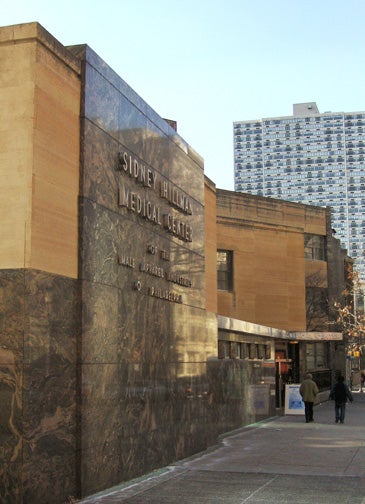
Aug. 12
By Alan Jaffe
For PlanPhilly
The apparent losing battle to preserve the Sidney Hillman Medical Center has turned a spotlight back on an overlooked period of Philadelphia regional architecture.
The Hillman is a distinctive example. Its luxurious pink gneiss and creamy yellow limestone exterior walls run at a diagonal to Chestnut Street near 22nd, distinguishing it as a quirky geometric experiment of mid-century architecture. The building’s purpose – to provide health care for union members of the apparel industry – also reflects the social agenda of the Modernist Movement.
A Chicago firm, the John Buck Co., plans to replace the 1950s building designed by Louis Magaziner with a 30-story tower of residences, offices, parking and retail space. Preserving and re-using the original structure would be a financial hardship, the company has said, and the city planning commission and historical commission have approved the plans.
The Hillman is one of many at-risk Modernist structures in Philadelphia, some designed by internationally renowned architects, but often overshadowed by the city’s historic Colonial and 19th century buildings.
“The buildings of the post-World War II years are now prime targets for removal because they are technically obsolete and somewhat out of fashion,” explained Frank Matero, a University of Pennsylvania professor of architecture and former chair of its graduate program in historic preservation. “They are in that awkward teenage phase – no longer an adolescent and not quite an adult. They’re neither old enough to be heritage nor new enough to be current.”
Developers and much of the public see these Modernist buildings as “standing in the way of progress,” said Lisa Ackerman, executive vice president of the World Monuments Fund, a private organization dedicated to saving treasured places around the globe. But the great Eastern cities, Ackerman said, “evolved over a long period of time. The dynamic you feel when you’re in Philadelphia is of a city that has not stood still. You don’t want the Modernist buildings wiped off the map, or there will be no recognition of how the 20th century played out in Philadelphia.”
One-two punch
Philadelphia has not been blind to its Modernist heritage. The adaptive reuse of the PSFS Building, an icon of International Style erected in 1932 by Howe and Lescaze, into a Loews hotel in 2000 was hailed as a brilliant conversion that preserved the original structure.
A national conference on protecting the recent past was held in Philadelphia at Loews’ PSFS hotel in 2000, and focused especially on Modernism after the Second World War that gave form to countless new building types in the suburbs, including airports, shopping malls, and public housing. Philadelphia was home to great proponents of the new schools of thought: Louis Kahn, Mitchell/Giurgola, and others, Matero said.
“In Greater Philadelphia, many of these buildings still stand because the city is so damn conservative. New York City, instead, tears itself down every 25 years,” he said. “”So Philadelphia is in a wonderful position to take on post-war Modernism as an important part of its built heritage.”
Despite aggressive development, New York City has been very proactive in protecting its mid to late 20th century architecture, Matero said, and Philadelphia is coming late to the game.
“Without recognition and legal protection, many important national and local examples are targets for tear-down by developers,” he said. If the Philadelphia Historical Commission “doesn’t have the political will or the money and staffing to address the situation, then advocacy groups should step in. They are the nongovernmental arm that can provide public support and pressure elected officials to demand that these things get done. … If we can’t show the ability to do it locally, I don’t see it happening.”
The approach can’t be on a “piecemeal, individual building basis,” Matero said, but should be a “focused, thematic survey” of the mid-century survivors. “Urban growth and change are inevitable and necessary; the key here is change responsive to the historic built environment, including the recent past.”
The Preservation Alliance for Greater Philadelphia has already launched a survey of the city’s historic resources, utilizing maps from the 19th through mid-20th centuries and GIS technology that will help identify buildings by their period.
For its part, the University of Pennsylvania architectural school has been sending students into the field to “identify those buildings which appear to have significance at the national and local level and which also appear to be threatened, based on what’s gong on around them,” Matero said.
“What we’re trying to do now is at least get some of these important regional buildings documented as part of the preservation students’ education. That documentation can be used to raise public awareness of the importance of these buildings, to get the ball rolling, to be used to make informed decisions about whether they can and should be preserved and re-used.” According to Matero, the Hillman Medical Center was on the students’ list for next January.
In late September and October, Penn also will host several programs – “a one-two punch” – on protecting Modernist structures. For the fall semester, Matero has organized a design studio on the preservation and adaptive reuse of Philip Johnson’s New York State Pavilion in Queens, which was erected for the 1964 Worlds Fair.
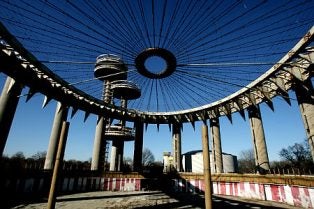
New York State Pavilion / New York Daily News
“It’s been on the World Monuments Fund endangered list for several years. Although the city of New York doesn’t have any money to preserve it now, technical studies and publicity campaigns are under way, including this design studio which should offer creative solutions to a New York icon. The studio results will be published and an exhibition held at the Center for Architecture in New York City next spring. Queens residents are excited about all the attention and its future preservation,” Matero said.
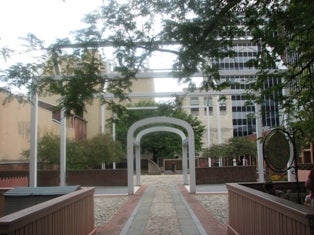
Robert Venturi’s innovative design for Franklin Court will be the subject of an exhibition at Penn this fall.
Another exhibition at Penn will look at Franklin Court, the 1976 post-Modernist, internationally renowned project at Independence National Historical Park in Old City. “The museum is about to undergo a much needed renovation, but it is unclear how much of the Venturi site design is going to be modified,” Matero said. The exhibition, “Ben’s House: Designing History in Philadelphia,” co-curated with William Whitaker, of the Architectural Archives at Penn, is timed to coincide with the school’s other efforts to bring attention to this early post-Modern design which changed the way archaeological sites were considered for interpretation internationally.
In late October, Penn will present a panel, “Philadelphia Modern: Preserving Beth Sholom,” which will feature a panel on the planned preservation project for the Elkins Park synagogue built in the 1950s by Frank Lloyd Wright and other Modernist sites in the region.
What’s been lost?
While Philadelphia is still “sitting on a treasure trove” of Modernist buildings, according to Matero, many have already fallen.
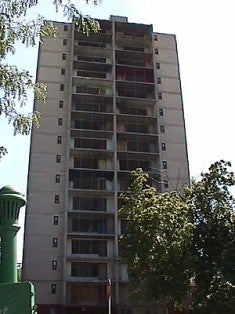
Mill Creek / Quondam
Archives curator Whitaker points to the Mill Creek public housing designed by Kahn in 1946-54. “They showed the variety of ways architects handled public housing – that they were not all cold spaces,” Whitaker said. Kahn used careful site planning and landscaping to create his “greenways.” The Mill Creek Housing was razed eight years ago.
In the suburbs, “remarkable examples” of single-family homes designed by Frank Weise, Arne Moe, Robert Venturi, Denise Scott Brown and others in the mid-1950s and 60s, which brought a richness and creative momentum to Modernism, have been “systematically demolished and replaced by McMansions,” Whitaker said.
The most public example of a late Modernist structure that has been lost is the original Liberty Bell Pavilion on Independence Mall. The glass pavilion was built in 1976 by the architectural firm Mitchell/Giurgola, and was torn down in 2003.
Designer Romaldo Giurgola was known for his work on the Penn Mutual building, the Australian Parliament building and other projects around the world. “The Bell Pavilion was one of his finest works,” Whitaker said. “He understood how architecture works in the city, paying attention to context and building on that larger history” of the Colonial structures around the site. The pavilion, which made the Liberty Bell visible 24 hours a day, was “a beautiful, elegant expression of bringing people together.”
What’s at risk?
Among the top list of Modernist buildings in Center City that require protection, Matero said, is the original Visitors Center at Love Park, designed in 1959-61 by Harbeson, Hough, Livingston & Larson, which now serves as Fairmount Park’s Welcome Center. The circular, stainless steel and glass building was “in the vanguard of pavilion design as both a functional statement and a symbol of modernity for its time.
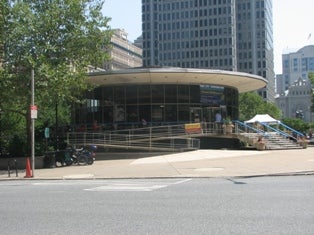
The circular, steel and glass Visitors Center at Love Park, designed by Harbeson, Hough, Livingston & Larson, was in the “vanguard of pavilion design.”
Today, it is very much invisible to the passerby,” he said. “It’s a very pure design that cannot tolerate much in the way of change,” although reversible interior modifications have been made in recent years. The building was the focus of recent documentation by Penn’s preservation students and, according to Matero, “the Fairmount Park Commission has been very receptive and supportive of its preservation.”
Another “sitting duck,” Matero said, is the Home Clinic No. 1, the blue-glazed brick and glass block building at Broad and Lombard Streets.
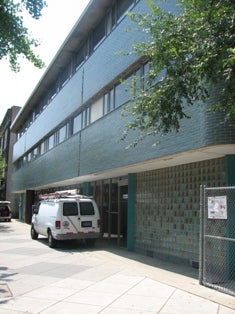
The green brick and block glass health clinic at Broad and Lombard Streets was built by Frank Lloyd Wright student Bob Bishop.
“In the 1950s to 60s, Philadelphia made remarkable investments in health centers,” Whitaker explained. The city built a half-dozen clinics, hiring respected architects who built them in the Modernist style. Home Clinic No. 1 was designed by Montgomery and Bishop. “Bob Bishop was in the first class of students of Frank Lloyd Wright at Taliesen, Wisconsin. He is the most significant example locally of an apprentice to Wright.” Protecting the building is a matter of “understanding the heritage we have; it’s part of our history,” Whitaker said. “We need to preserve not only those that are world renowned, but those that show the dissemination of life in our region.”
A high profile, very functional Modernist structure at risk is the Police Administration Building at 8th and Race Streets. Built in 1963 by Geddes Brecher Qualls Cunningham (GBQC), the structure is an “incredibly important early work of prefabricated, precast concrete. It was a marvel of engineering for its day, at the cutting edge of what we were able to do technologically,” Whitaker said. But there has been talk of selling and converting the building into condominiums, which could involve alterations that would affect the architectural and historic integrity of the building.
The focus on the Modern Movement must go beyond Philadelphia to the surrounding counties, where some of the best examples remain, Whitaker said. “We have to take a broader view and look at apartment buildings, corporate headquarters, and single-family homes,” he said.
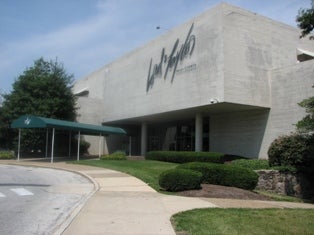
The multi-level, streamlined Lord & Taylor building in Bala Cynwyd was the work of renowned mid-century designer Raymond Lowey.
A great example is the Lord & Taylor building in Bala Cynwyd, designed by Raymond Lowey, a “tastemaker” of the 1950s who worked on the streamlining style of cars and trains, Whitaker said. When the retailer decided to expand from New York to suburban areas, its second store opened here. “It takes that idea of the big-box store, but is much more stylized,” Whitaker said. “It marks a moment that has passed in how we’d design retail buildings.”
Ackerman, of the World Monuments Fund, said many of the schools and libraries erected as part of the expansion into the suburbs in the post-war years also were “amazingly exuberant buildings.”
“They are such strong symbols of the best thinking of the time, using the best materials possible.”
What’s old enough?
In a city with so much rich history and so many sites in need of preservation, the competition for attention is deep. “The 19th century doesn’t even get its due,” Matero conceded. “Philadelphia is a great American city in terms of every period, from the 17th to the late 20th century; there are buildings that are significant locally, regionally, nationally and internationally.”
Matero himself has not spent the better part of his career examining Modernism. But a personal link was made when he joined the effort to preserve the New York State Pavilion in Queens last year. “It was the first time I found myself working on a building that is now considered historic that I saw when I was young and remember it. That never happened to me before. It was 1964; I was 11 years old. And now I’m doing a preservation project on it.
“One of the interesting things about preserving post-war heritage is that it has gotten tremendous support from many contemporary architects, particularly the older generation. I think this is because these buildings represent the legacies of their teachers. They were the buildings and the dominant design philosophies of the time that they studied when they were in school,” Matero said. “These buildings are not how we define being modern any longer. But they have currency because they are the progenitors of the current condition.”
A similar situation occurred in the 1930s, Matero said, when a handful of architectural historians argued for the preservation of the early 19th-century Second Bank for inclusion in Independence National Historic Park. “It wasn’t 18th-century Colonial, so it wasn’t considered historical enough or relevant. In 1939, a building from 1821 did not have the age pedigree.”
In the 1970s, 100-year-old buildings by Philadelphian Frank Furness were being torn down, and it took the protests of a small group of designers and historians to advocate the importance of his work. “Now we’re talking about buildings that are only 50 years old. It takes less time for something to become historical, or more appropriately, out of time,” Matero explained, “because everything is changing faster.”
What to save?
A survey of the region’s Modernist resources, whether it’s done by the Preservation Alliance, Penn, or the city, or a collaborative effort, must “identify what’s important, what’s relevant enough to save,” Matero said. The purpose is not to try to save everything. “You have to know enough about what to tear down as much as what to preserve. And you have to have creative solutions” for projects chosen for preservation.
The criteria isn’t what is “good, better, best” in determining which buildings should define the Philadelphia of the future. “I think for Philadelphia what has to be done is to look at these buildings and their contributions to the urban ensemble. What defines our streetscapes, our neighborhoods? What contributes? What makes Philadelphia regional? What makes it local? What makes it national?” Matero said.
“And we have to be able to incorporate these values into what makes economic sense. Our decision as to what to preserve in the end must address our definition of what it means to have a livable city. For me that includes the evidence of time.”
Whether it’s the Visitors Center, Lord and Taylor, or the Hillman Center, each example “needs its day in court,” Matero said. “With any of these buildings, there has to be a serious assessment of their historical significance and their value regardless of age.”
Contact the reporter at alanjaffe@mac.com
WHYY is your source for fact-based, in-depth journalism and information. As a nonprofit organization, we rely on financial support from readers like you. Please give today.



